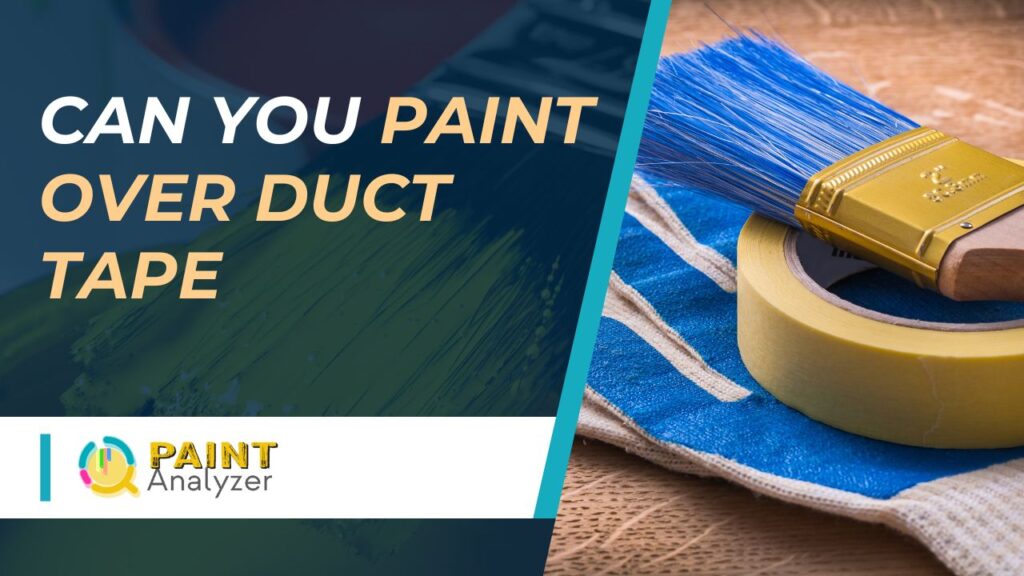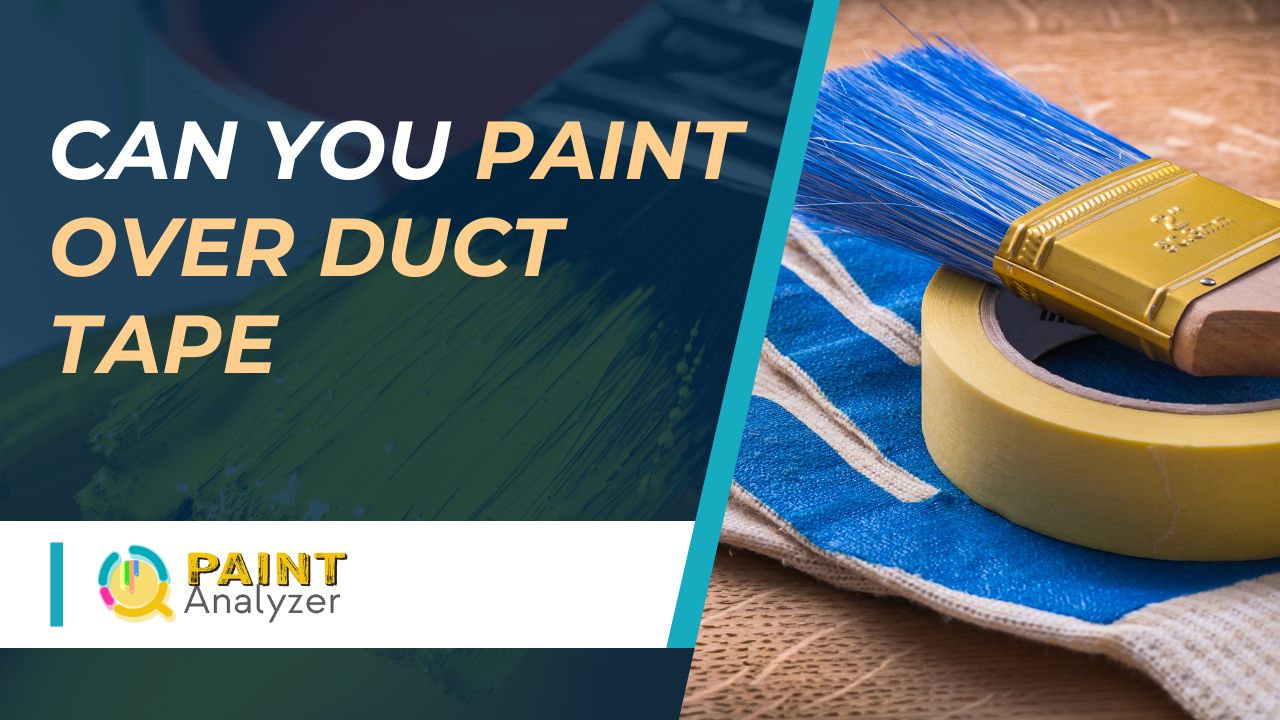Acrylic paint can be used to paint over duct tape, but it is not recommended. If the duct tape is of poor quality, the adhesive may not be strong enough to adhere to the surface, causing the paint to lift or crack.
If you decide to paint over duct tape, ensure the surface is clean and free of dirt and debris and that any primer you use is appropriate for the type of surface you paint. Furthermore, the paint should be of good quality and applied in thin coats to ensure even coverage.
This guide will walk you through how to paint over duct tape, so if you want to try it, keep reading to learn more!

Is It Recommended to Paint Over Duct Tape?
It is not recommended to paint directly over duct tape. Duct tape is not designed to be a paintable surface, and the paint may not adhere well to its surface. Additionally, duct tape’s texture and adhesive nature can cause paint to peel or chip over time.
If you have duct tape on a surface you want to paint, the best approach is to remove the duct tape before painting. Here’s a general guide on how to remove duct tape and prepare the surface for painting:
- Peeling off the Duct Tape: Carefully peel off the duct tape from the surface. Use a slow and steady motion to avoid damaging the underlying material.
- Removing Residue: After removing the duct tape, adhesive residue might be left on the surface. You can use a commercial adhesive remover or gentle household solutions like rubbing alcohol or soapy water to remove the sticky residue.
- Cleaning the Surface: Clean the area thoroughly to ensure no dirt, grease, or residue left that might hinder paint adhesion.
- Sanding (If Necessary): If the surface has any rough spots or uneven areas, you may need to lightly sand the area to create a smooth and paintable surface.
- Applying Primer: Before painting, it’s a good idea to apply a suitable primer to the prepared surface. A primer will improve paint adhesion and help the paint adhere uniformly to the surface.
- Painting: Once the primer has dried, you can paint the surface using the desired paint type and color.
How Do You Get Paint to Stick to Duct Tape? A step-by-step guide
Painting on duct tape can be a great way to add a unique look to your projects and creations. But getting the paint to stick to the duct tape and stay put can be challenging. Here’s a step-by-step guide to help you get the job done right:
Step 1: Prepare the duct tape
Begin by ensuring that the duct tape surface is clean and dry. Carefully wipe away any dust, dirt, or other debris that could interfere with the paint’s adhesion. It may be helpful to use a lint-free cloth to keep the surface clean and free of particles.
Inspect for any signs of oil, grease, and other substances that could interfere with the painting process. If necessary, use a solvent to remove any contaminants before continuing. Additionally, it’s crucial to ensure that the surface is completely dry and free from any residues. This will not only promote better adhesion but also enhance the durability of your paint job. If you are considering applying a new finish, be aware that the question often arises: can you paint over lacquer? The answer typically depends on the type of paint you are using and the condition of the lacquer surface.
Step 2: Apply a primer
Before you start painting, applying a primer to the duct tape is essential. This will help the paint stick better and last longer. Use a spray or brush-on primer in thin, even coats.
Step 3: Allow the primer to dry
Once you’ve applied the primer, allow it to dry before painting. Depending on the primer you used and the room temperature, this could take a few minutes to a few hours.
Step 4: Choose the right paint
Not all paints are created equal, so choose the right kind for your project. Latex and acrylic paints are best for painting on duct tape, as they’re easily removable and flexible.
Step 5: Apply the paint
It’s time to start painting now that you’ve chosen the right paint. Begin with a light coat and let it dry before adding more coats. Apply with even and light strokes, careful not to press too hard on the duct tape. To avoid lap marks, keep a wet edge on the paint. Add a second coat if your first coat of paint is too thin.
Step 6: Allow the paint to dry
Allow the paint to dry completely before applying the duct tape after you finish painting. Depending on the paint you used and the room’s temperature, this could take several hours.
What kind of Duct tape can be painted over?
Any duct tape can be painted over, but it is important to consider the type of paint used and the substrate to which the duct tape adheres. For best results, use high-quality duct tape designed to be painted over, such as one made with an acrylic-based adhesive and a matte finish.
This type of duct tape is designed to create a better bond with the underlying surface, making it easier to paint and ensuring that the paint will adhere properly. Additionally, before painting, ensure that the duct tape has firmly adhered to the surface and that all loose edges are sealed.
This will help to ensure that the paint does not seep underneath the tape, resulting in an uneven finish.
Can You Spray Paint Over Duct Tape?
Yes, you can spray paint over duct tape. Before attempting, the duct tape should be completely dry and free of dust, dirt, or other debris. To ensure the best results, it is recommended that you use a spray primer before you apply the paint.
This will help create a better bond between the duct tape and the paint, making it more likely to adhere properly. It is also important to hold the spray can reach several inches away from the duct tape while painting, as too close contact could damage the adhesive. Additionally, multiple thin coats of paint are preferable to a single thick one, as the thin coats will be more likely to adhere and dry evenly.
Is it Possible to Paint over Duct Tape on Shower Walls?
Yes, it is possible to paint your shower walls over duct tape. However, it’s important to properly prepare the surface by cleaning and sanding the duct tape to ensure the paint adheres well. Using a good quality waterproof paint designed for wet environments will help ensure a long-lasting finish.
Alternatives to painting over duct tape
Painting over duct tape can be difficult, as the adhesive residue can cause the new paint to peel or blister. Fortunately, there are alternative solutions to transforming the look of duct tape.
One option is to cover it with a thin layer of drywall compound. Once the drywall compound dries, it can be sanded, primed, and painted.
Another option is to use a self-adhesive wallpaper to cover the duct tape. This solution can be a great way to add a decorative touch to the space.
If you want to avoid painting altogether, you can use a variety of specialty tapes, such as leather-look or specialty duct tape with designs. These solutions can disguise the duct tape while providing a great look to the space.
Acrylic Painting Over Duct Tape
Conclusion
It is possible to paint over duct tape, but there are a few essential steps to ensure a successful outcome. Before applying paint, use the proper duct tape and prepare the surface. Furthermore, if you intend to spray paint over duct tape, use light, even coats of paint to ensure a successful result.
But keep in mind that using duct tape as a permanent solution for any project is not a good idea, and if you find yourself in a situation where you must paint over duct tape, it is best to keep the project temporary.
